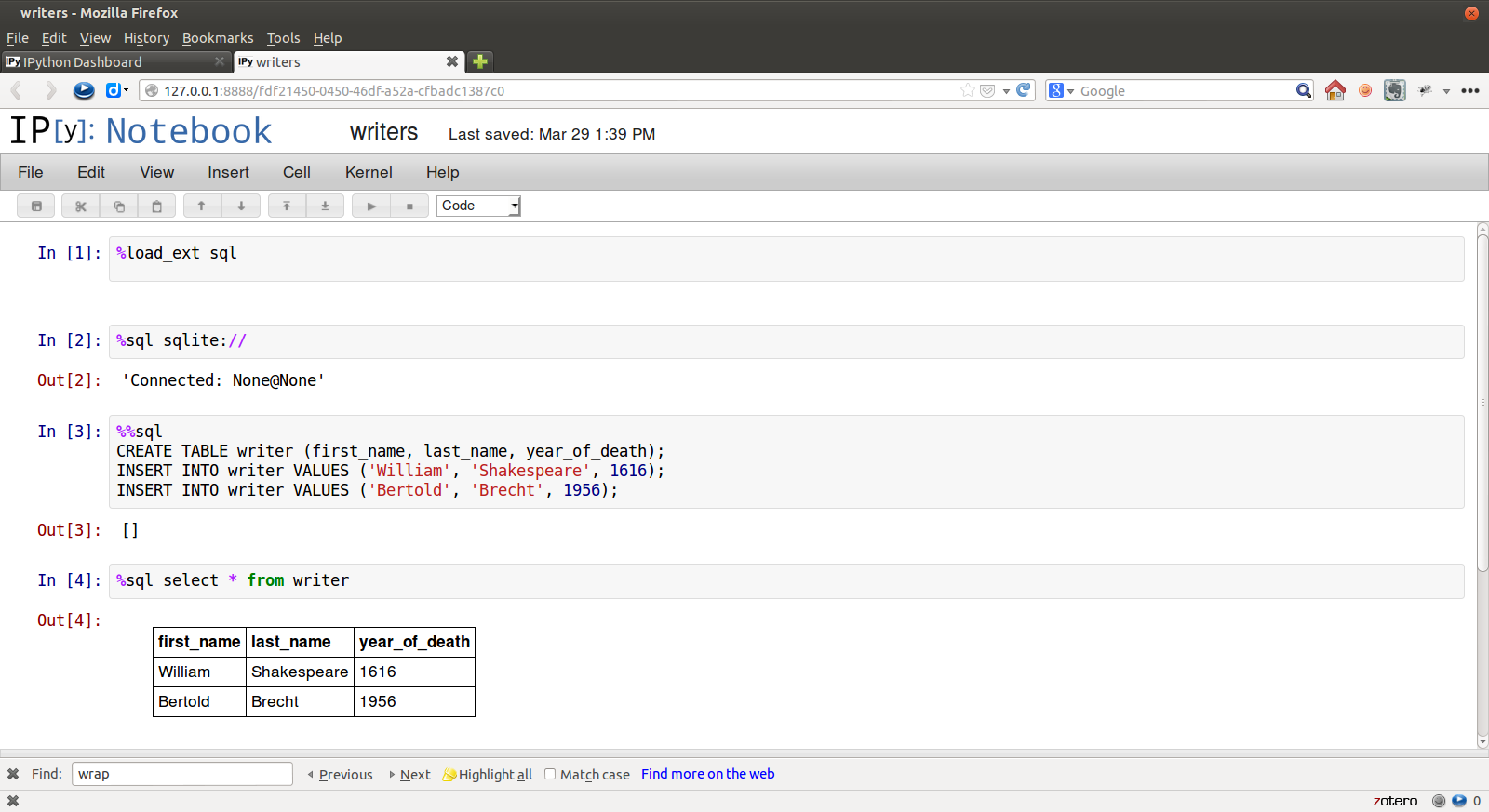| Author: | Catherine Devlin, http://catherinedevlin.blogspot.com |
|---|
Introduces a %sql (or %%sql) magic.
Connect to a database, using SQLAlchemy connect strings, then issue SQL commands within IPython or IPython Notebook.
Examples:
In [1]: %load_ext sql In [2]: %%sql postgresql://will:longliveliz@localhost/shakes ...: select * from character ...: where abbrev = 'ALICE' ...: Out[2]: [(u'Alice', u'Alice', u'ALICE', u'a lady attending on Princess Katherine', 22)] In [3]: result = _ In [4]: print(result) charid charname abbrev description speechcount ================================================================================= Alice Alice ALICE a lady attending on Princess Katherine 22 In [4]: result.keys Out[5]: [u'charid', u'charname', u'abbrev', u'description', u'speechcount'] In [6]: result[0][0] Out[6]: u'Alice' In [7]: result[0].description Out[7]: u'a lady attending on Princess Katherine'
After the first connection, connect info can be omitted:
In [8]: %sql select count(*) from work Out[8]: [(43L,)]
Connections to multiple databases can be maintained. You can refer to an existing connection by username@database:
In [9]: %%sql will@shakes ...: select charname, speechcount from character ...: where speechcount = (select max(speechcount) ...: from character); ...: Out[9]: [(u'Poet', 733)] In [10]: print(_) charname speechcount ====================== Poet 733
You may use multiple SQL statements inside a single cell, but you will only see any query results from the last of them, so this really only makes sense for statements with no output:
In [11]: %%sql sqlite://
....: CREATE TABLE writer (first_name, last_name, year_of_death);
....: INSERT INTO writer VALUES ('William', 'Shakespeare', 1616);
....: INSERT INTO writer VALUES ('Bertold', 'Brecht', 1956);
....:
Out[11]: []
Bind variables (bind parameters) can be used in the "named" (:x) style. The variable names used should be defined in the local namespace:
In [12]: name = 'Countess' In [13]: %sql select description from character where charname = :name Out[13]: [(u'mother to Bertram',)]
As a convenience, dict-style access for result sets is supported, with the leftmost column serving as key, for unique values.
In [14]: result = %sql select * from work 43 rows affected. In [15]: result['richard2'] Out[15]: (u'richard2', u'Richard II', u'History of Richard II', 1595, u'h', None, u'Moby', 22411, 628)
Connection strings are SQLAlchemy standard.
Some example connection strings:
mysql+pymysql://scott:tiger@localhost/foo oracle://scott:[email protected]:1521/sidname sqlite:// sqlite:///foo.db
Note that mysql and mysql+pymysql connections (and perhaps others)
don't read your client character set information from .my.cnf. You need
to specify it in the connection string:
mysql+pymysql://scott:tiger@localhost/foo?charset=utf8
Query results are loaded as lists, so very large result sets may use up your system's memory and/or hang your browser. There is no autolimit by default. However, autolimit (if set) limits the size of the result set (usually with a LIMIT clause in the SQL). displaylimit is similar, but the entire result set is still pulled into memory (for later analysis); only the screen display is truncated.
In [2]: %config SqlMagic
SqlMagic options
--------------
SqlMagic.autolimit=<Int>
Current: 0
Automatically limit the size of the returned result sets
SqlMagic.autopandas=<Bool>
Current: False
Return Pandas DataFrames instead of regular result sets
SqlMagic.displaylimit=<Int>
Current: 0
Automatically limit the number of rows displayed (full result set is still
stored)
SqlMagic.feedback=<Bool>
Current: True
Print number of rows affected by DML
SqlMagic.short_errors=<Bool>
Current: True
Don't display the full traceback on SQL Programming Error
SqlMagic.style=<Unicode>
Current: 'DEFAULT'
Set the table printing style to any of prettytable's defined styles
(currently DEFAULT, MSWORD_FRIENDLY, PLAIN_COLUMNS, RANDOM)
In[3]: %config SqlMagic.feedback = False
If you have installed pandas, you can use a result set's
.DataFrame() method:
In [3]: result = %sql SELECT * FROM character WHERE speechcount > 25 In [4]: dataframe = result.DataFrame()
If you have installed matplotlib, you can use a result set's
.plot(), .pie(), and .bar() methods for quick plotting:
In[5]: result = %sql SELECT title, totalwords FROM work WHERE genretype = 'c' In[6]: %matplotlib inline In[7]: result.pie()
Install the lastest release with:
pip install ipython-sql
or download from https://github.com/catherinedevlin/ipython-sql and:
cd ipython-sql sudo python setup.py install
https://github.com/catherinedevlin/ipython-sql
- Matthias Bussonnier for help with configuration
- Olivier Le Thanh Duong for %config fixes and improvements
- [Distribute](http://pypi.python.org/pypi/distribute)
- [Buildout](http://www.buildout.org/)
- [modern-package-template](http://pypi.python.org/pypi/modern-package-template)
- Mike Wilson for bind variable code
- Thomas Kluyver and Steve Holden for debugging help

